|
Ibiza History Culture:
One of your most famous sculptures is "Es Verro" (also known as "The
Shouting Man") in San Antonio. How important is this statue to you?
Antonio Hormigo:
I understand that "Es Verro" is very well known but it's definitely
not one of my best sculptures.
San Antonio
council asked me if I could make a monument to honour the farming community
of San Antonio.
I didn't
feel that a statue of a working farmer would be right so I thought maybe a "verro",
who was the town's tough guy, would be more appropriate and I decided to sculpt
him shouting an "uc", which symbolizes the start of a local fiesta.
The aim
of my sculpture was to represent the positive side of living in San Antonio.
The monument
was inaugurated in 1977 and sometimes I think that if I had to do it again maybe
I would have done it differently.
Another
reason why "Es Verro" isn't one of my favourites is the fact that
it's made out of stone. Wood is definitely my favourite material.
LI:
Is that because wood is easier to work with?
AH:
Yes, I find it very pleasant to work with. I tend to use all types of wood,
everything ranging from the normal pine tree to olive and oak trees, but nearly
always Ibicencan wood.
Although
I have to say that the type of wood isn't really important to me, it's the shape
that gets my imagination going.
LI:
Where or in what do you find inspiration?
AH:
I get my inspiration from the grain and the natural shapes in the wood.
I always
try to incorporate the branches into the sculpture and work with what I have,
without adding any artificial parts.
The natural
branches are strong but false extensions are weak and unnatural looking.
I don't
usually plan what I'm going to sculpt before I start; I just let the wood inspire
me.
Even when
I do plan out my work it usually ends up being the complete opposite to my initial
idea.
The olive
tree and the carob tree I would have to say are two of my favourites as their
shapes are so diverse.
LI:
As an active sculptor you must use a lot of wood, where do you get your materials?
AH:
I have never cut down a tree in my life so I can definitely say that my years
of work haven't affected Ibiza's environment.
Actually,
one of my best sculptures was made out of a large piece of driftwood. Even to
this day I'm still not sure what type of wood it was. Some people believe it
was beech but, as I said earlier, the type of wood isn't really important to
me, it's the character of the wood that matters.
So, in
a way, you could say I also recycle as well as creating art.
LI:
On average, how long do you take to complete a sculpture?
AH:
It all depends on the size of the sculpture but usually no longer than five
months. I work every day on various pieces at the same time. I have no time
limit so if I get stuck on one sculpture I just move on to the next.
LI:
Do you consider that the significance of your art is easily captured?
AH:
I believe that no one but the artist knows the real meaning of his or her art.
Most of
my sculptures are not difficult to understand but there will always be some
hidden meaning that only I will know.
LI:
Do you think art is a profession that can be taught or is it a gift you are
born with?
AH:
It can be taught but it all depends on the person. If there is art on the inside,
it's always easier to develop art on the outside. But, as I say, it depends
on each individual artist. I consider myself to be very lucky because, in a
way, my art has always came from the inside.
LI:
Do you think it's easier to be artistic if you are brought-up in an artistic
environment?
AH:
Without a doubt. I was surrounded by art from early childhood; my father was
an artist and my brothers were also very artistic.
For me
it all seemed very natural.
LI:
One of the main characteristics that define your art is the fact that most of
your sculptures haven't got facial features, why?
AH:
After many years sitting with my father all day in his workshop making little
wooden faces that would later be made into bracelets and necklaces to sell to
the tourists, I have developed a certain phobia to sculpting faces.
I suppose
I'm rebelling from all those years of being stuck in my father's workshop!
Another
reason my sculptures lack defining facial expression is because I don't feel
I can take the liberty of adding personal features because I haven't got that
information about the character.
Although,
most people find that my art transmits enough sentiment and expression without
the need to focus on minor facial type details.
LI:
Rumour has it that Anthony Quinn's son, Lorenzo Quinn, is one of your many admirers.
AH:
Lorenzo Quinn is just one of many artists that I share a strong friendship with.
I still
remember the first time Lorenzo came to my house to see my work.
He is a
very nice man and I have great respect for him and his art.
LI:
Who buys most of your work?
AH:
Mostly people from outside Ibiza, which is one of the reasons why I don't exhibit
much on the island.
The
German people seem to admire my work more that others and are my best customers.
However, my latest project is a sculpture of a dove for an English man, which
I'm going to call "Dove of peace, trophy of war".
LI:
Have you any exhibitions planned for the near future?
AH:
I hold an exhibition every two years in Can Berri gallery in San Agustin.
The next
one is planned for 2002 and I have already all my sculptures completed.
| 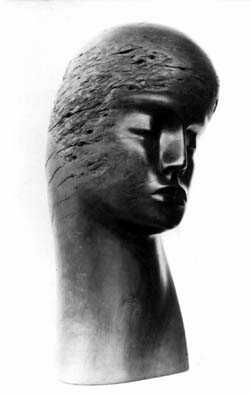
Enso�aci�n - 1978
Almendro, 70 x 35 cm
|
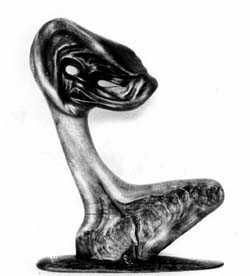
Hemicr�nea - 1978
Algarrobo, 65 x 40 cm
|
| 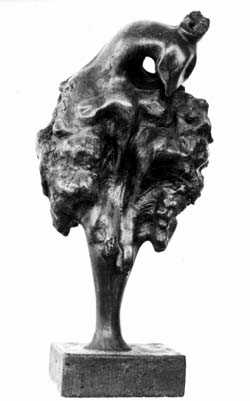
El Reposo - 1979
Olivo, 46 x 33 cm
|
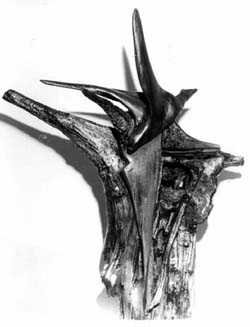
Espantap�jaros - 1979
Sabina, 130 x 50 cm
|
| 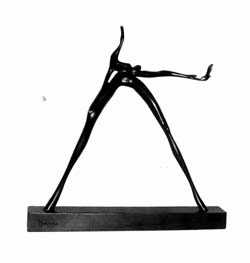
Mujer Con Paloma - 1983
Pino, 70 x 60 cm
|
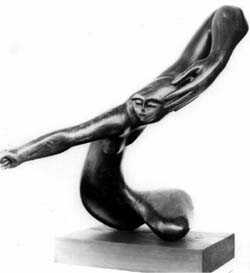
Amazona - 1987
Pino, 90 x 80 cm
|
| All pictures courtesy
of Antonio Hormigo Escandell |
|